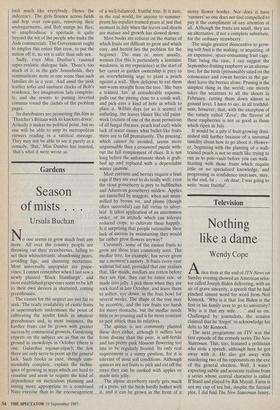Gardens
Season of mists .
Ursula Buchan
No one seems to grow much fruit any more. All over the country people are throwing out their strawberries, failing to net their whitecurrants, abandoning pears, avoiding figs, and shunning nectarines. Most universally unpopular are grape- vines; I cannot remember when I last saw a newly planted 'Black Hamburgh', and most established grapevines seem to be left to their own devices in shattered, rotting greenhouses.
The causes for the neglect are not far to seek. The ready availability of exotic fruits in supermarkets undermines the point of cultivating the tender kinds in amateur greenhouses and, in most instances, the hardier fruits can be grown with greater success by commercial growers. Gardening experts on the subject are as thin on the ground as snowdrops in October (there is one, Galanthus reginae-olgae); the few there are only serve to point up the general lack. Such books as exist, though com- mendably complete, explain the techni- ques of growing in ways which are hard to visualise and seem to require the kind of dependence on meticulous planning and timing more appropriate to a combined Nato exercise than to the encouragement
of a well-balanced, fruitful tree. It is rare, in the real world, for anyone to summer- prune his espalier-trained pears at just that moment in July when the leaves and shoots are mature and growth has slowed down.
Most books are reticent on the matter of which fruits are difficult to grow and which easy, and herein lies the problem for the beginner. The man or, more usually, woman (for this is particularly a feminine weakness, in my experience) at the start of her career in garden ownership is prey to an overwhelming urge to plant a peach against a wall. 'How delicious to eat them sun-warm straight from the tree.' She buys a trained 'fan' at considerable expense, pulls out the paving close to a south wall, and pick-axes a kind of hole in which to place it. Within days (or so it seems) of unfurling, the leaves blister like old paint- work (victims of one of the most pernicious of all fungal diseases, peach leaf curl) while lack of water causes what bullet-like fruits there are to fall prematurely. The pruning, which cannot be avoided, seems more unguessable than a crossword puzzle with- out the full complement of clues. It is not long before the unfortunate shrub is grub- bed up and replaced with a dependable winter jasmine.
Most currants and berries require a fruit cage if they are ever to do really well; even the stout gooseberry is prey to bullfinches and Atherican gooseberry mildew. Apples are tunnelled by maggots, when not mum- mified by brown rot, and plums (though often successful) can fall victim to silver- leaf. It takes application of an uncommon order, or an attitude which can tolerate reduced crops, to cultivate these happily. Is it surprising that people rationalise their lack of success by maintaining they would far rather grow flowers anyway?
Curiously, some of the easiest fruits to grow are those least commonly seen. The medlar tree, for example, has never given me a moment's anxiety. It fruits every year without fail and, provided that one realises that, like maids, medlars are rotten before they are ripe, they can be eaten raw, or made into jelly. I pick them when they are rock-hard in late October, and leave them to soften, eye down, in the fruit bowl for several weeks. The shape of the tree may be eccentric, and the raw fruits too harsh for many stomachs, but the medlar needs little or no pruning and is far more resistant to pest attack than its relatives.
The quince is not commonly planted these days either, although it suffers less from disease than the pear, is self-fertile and has pretty pink blossom flowering too late to be regularly frosted. Its only real requirement is a sunny position, for it is tolerant of most soil conditions. Although quinces are not fruits to pick and eat off the trees they can be cooked with apples or made into jelly.
The alpine strawberry rarely gets much of a press, yet the birds hardly bother with it, and it can be grown in the front of a sunny flower border. Nor does it have `runners' so one does not feel compelled to pay it the compliment of any attention at all. Although the fruits are small, they are an alternative, if not a complete substitute, for the ordinary strawberry.
The single greatest disincentive to grow- ing soft fruit is the making, or acquiring, of an expensive, space-consuming fruit cage. That being the case, I can suggest the September-fruiting raspberry as an alterna- tive, for the birds (presumably sated on the cotoneaster and rowan berries in the gar- den) leave the berries alone. Pruning is the simplest thing in the world; one merely takes the secateurs to all the shoots in February, cutting them down almost to ground level. I have to say, in all truthful- ness, however, that, with the exception of the variety called `Zeva', the flavour of these raspberries is not as good as those which ripen in July.
It would be a pity if fruit-growing dimi- nished still further because of a universal timidity about how to go about it. Howev- er, beginning with the planting of a wall- trained peach is not so much like trying to run as to pole-vault before you can walk. Starting with those fruits which require little or no specialised knowledge, and progressing as confidence increases, may, in the end, be . . . oh dear, I was going to write 'more fruitful'.


































































 Previous page
Previous page